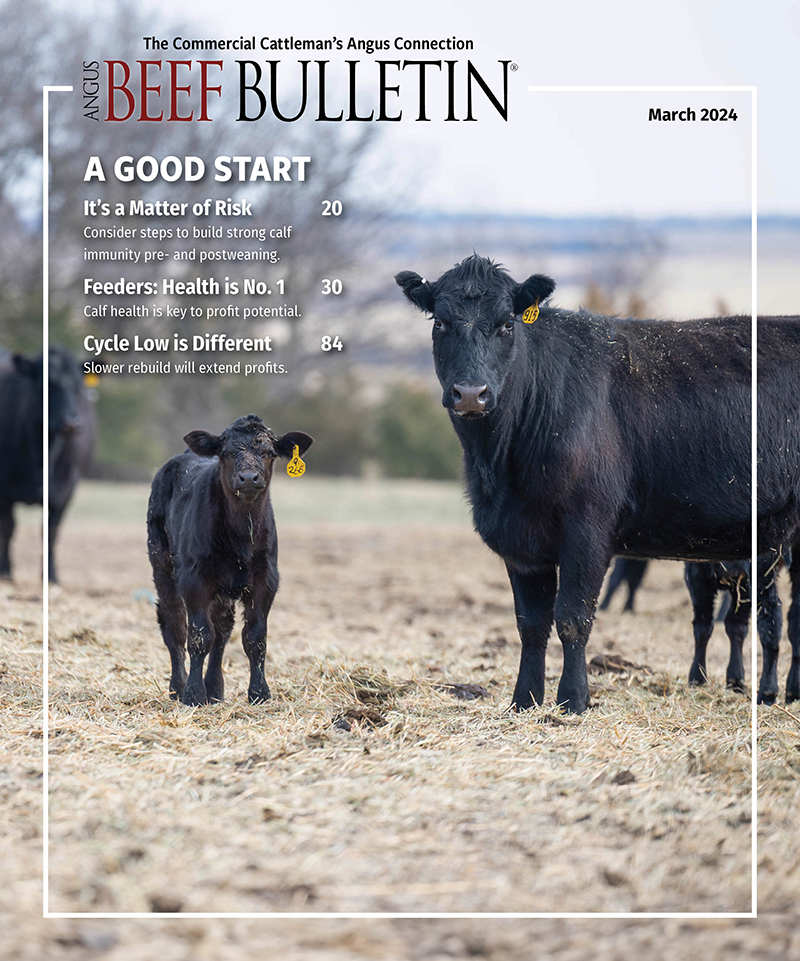
Can You Program Fertility?
How nutrition can affect future puberty attainment, fertility and the ovarian reserve.
Replacement heifers are an incredibly important, yet expensive part of our operations. Wouldn’t it be great if we could program fertility in our breeding females?
For an episode of the Angus at Work podcast, our team sat down with the University of Wyoming’s (UW) Shelby Rosasco to discuss the role developmental programming has within your operation.
Developmental programming
Developmental programming, or nutritional programming, refers to the developmental window where we can have an effect on a female’s future reproduction, according to Rosasco.
“Within that first year, if you think about that heifer, even though she did a lot of development during gestation, she’s still going through a lot of changes,” said Rosasco, an assistant professor and UW Extension beef specialist. “She’s working on attaining puberty. That has a big impact on her reproductive tract development, as well as actual development within the brain and how that heifer is functioning from a hormone profile.”
But that window offers producers an ideal time to alter management for the potential benefit of their developing heifers.
Referencing a preweaning study she presented at the Range Beef Cow Symposium in 2021 where researchers looked at puberty attainment, Rosasco found that when heifer calves had a higher-concentrate diet between 3 and 6 months of age, researchers could potentially induce precocious (early) puberty.
“They did a second stairstep diet in that one where they fed a higher rate of gain between 6 and 9 months of age,” said Rosasco. “We actually saw really good timing of puberty attainment between 11 and 13 months of age, which is ideal and what we want in our heifers. And then, we talked about some stairstep diets in the postweaning period.”
That’s where Rosasco’s research has been focused. Stairstep diets closer to 14 or 15 months of age have shown a positive effect on the ovarian reserve (the number of microscopic follicles within the ovary), which could positively influence longevity.
Stairstep diets
But what are stairstep diets? According to Rosasco, they’re fairly simple. It’s really like an actual stairstep: Heifers will experience periods where they’re on a low rate of gain and periods of a high rate of gain. Those rates can be reversed, and there can be multiple levels within the system.
Precocious puberty is something that can be extremely difficult to manage in some production systems. If heifers start attaining puberty before weaning, there would be an opportunity for them to become bred way too early in their life. An accidental breeding could be detrimental from a developmental standpoint, said Rosasco.
“We really don’t want that. And that’s where some of those studies actually showed that pushing nutrition between that 6- to 9-month time point, we can actually time when that puberty is occurring,” noted Rosasco. “We can potentially avoid precocious puberty by having the majority of those heifers attain puberty between about 10 to 13 months of age.”
Drylot vs. native range
Though many of the studies have been conducted in a drylot scenario, there are a lot of producers who develop their heifers grazing native range. While drylotting gives researchers greater control over nutrient intake, similar results can be seen with a few alterations for heifers on grass.
One of the things Rosasco wanted to answer for producers was whether supplementing range-developed females to simulate a stairstepping diet could result in the same outcomes.
“Those heifers were out grazing the majority of the day ... or the majority of the week. Three days during the week they got brought in each morning and we individually supplemented them on those three days to target that stairstep diet,” said Rosasco, noting that 2019 in New Mexico saw stairstep diets happening naturally due to a green-up. “But it was really nice to be able to see the increase in primordial follicle numbers in both the native range-developed heifers as well as the drylot-developed heifers. It gives producers options so they can target a stairstep style of gain, whether they’re in the drylot or out on pasture.”
The information above is summarized from the March 1, 2022, episode of Angus at Work. To access the full episode, and learn more about developmental programming and its effect on reproduction and ovarian reserve, check out Angus at Work on Apple Podcasts or use the QR code to save time.




